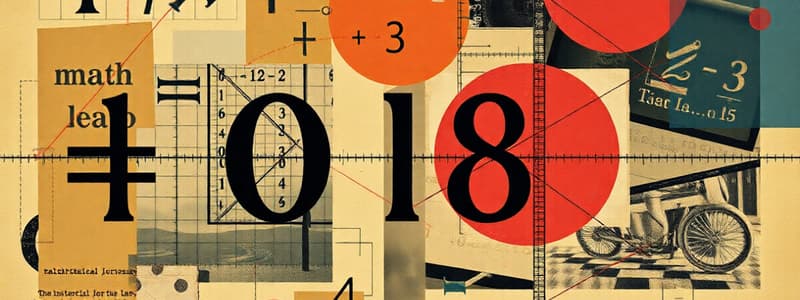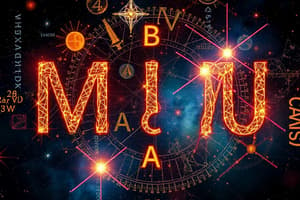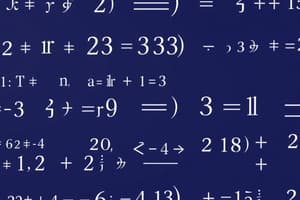Podcast
Questions and Answers
What is a defining feature of mathematical language as a system of communication?
What is a defining feature of mathematical language as a system of communication?
- It is designed for everyday conversations.
- It utilizes symbols and follows specific rules. (correct)
- It primarily uses spoken words.
- It consists of complex syntax only.
Which of the following is NOT a characteristic of mathematical expressions?
Which of the following is NOT a characteristic of mathematical expressions?
- They can convey abstract ideas.
- They represent quantities or variables.
- They can be simplified or evaluated.
- They state complete thoughts. (correct)
In the expression '5 + 21 = 26', what role does the '=' symbol play?
In the expression '5 + 21 = 26', what role does the '=' symbol play?
- It transforms the expression into a variable.
- It indicates a numerical operation.
- It serves as a relational verb. (correct)
- It signifies a complete thought.
What type of mathematical statement can be true, false, or sometimes true?
What type of mathematical statement can be true, false, or sometimes true?
Which of the following is an example of a mathematical expression?
Which of the following is an example of a mathematical expression?
Which of the following correctly describes the term 'variables' in mathematical language?
Which of the following correctly describes the term 'variables' in mathematical language?
What is the primary purpose of mathematical language according to the content?
What is the primary purpose of mathematical language according to the content?
Which of the following represents a mathematical sentence?
Which of the following represents a mathematical sentence?
Flashcards are hidden until you start studying
Study Notes
Language and Symbols in Mathematics
- Mathematics functions as a unique language composed of symbols and expressions.
- It requires specific symbols and sounds alongside rules governing their use, akin to grammar in traditional languages.
- A community of users must exist who understand and interpret these symbols collectively.
Nature of Mathematics as a Communication System
- Mathematical language communicates abstract concepts, ideas, and theories distinct from everyday language.
- It enables the expression of logical thoughts and intricate distinctions clearly and accurately.
Mathematical Expressions and Operations
- Basic mathematical symbols include digits (0-9), operations (+, -, /, x), sets (U), and variables (a, b, c, ... , x, y, z).
- Special symbols include those for equality (=) and inequality (>, <).
- The language allows concise expression of complex ideas, for example:
- "The sum of five and a number" can be expressed mathematically.
- "Twenty-five times a number" can also be simplified to an expression.
The Power of Mathematical Language
- Mathematical language serves as a powerful tool due to its ability to convey complex thoughts with ease.
- Examples demonstrate how mathematical expressions can succinctly articulate ideas:
- The statement "The product of two numbers is equal to 51" translates to xy=51.
- The work formula can be expressed as w=Fd.
Expressions vs. Sentences in Mathematics
- Mathematical expressions are like English nouns representing quantities or concepts but do not convey complete thoughts (e.g., x+2).
- Mathematical sentences, akin to complete English sentences, express full ideas (e.g., 5 + 21 = 26) and always involve relational symbols.
- These sentences can provide statements that are:
- Always true
- Always false
- Sometimes true or false.
Identification of Mathematical Forms
- Differentiation between expressions and sentences is crucial for better understanding:
- Examples of expressions: x+2, 5x=25.
- Examples of sentences: 5 + 21 = 26, 9x=18.
Studying That Suits You
Use AI to generate personalized quizzes and flashcards to suit your learning preferences.




